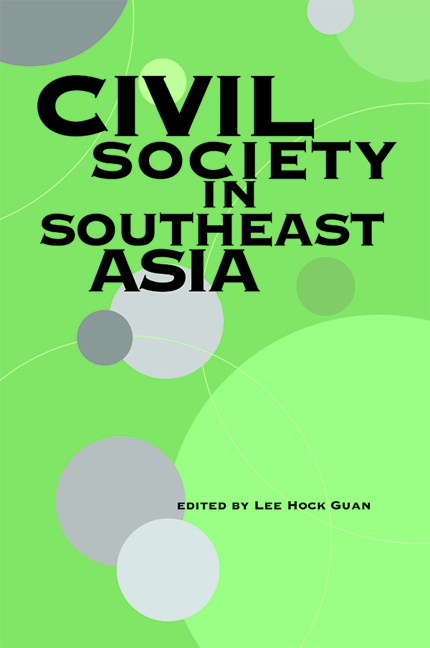Book contents
- Frontmatter
- Contents
- Preface
- About the Contributors
- 1 Introduction: Civil Society in Southeast Asia
- 2 Islam, Constitutional Democracy, and the Islamic State in Malaysia
- 3 Cracks in the Wall of Separation?: The Church, Civil Society, and the State in the Philippines
- 4 New Buddhism, Urban Space, and Virtual Civil Society
- 5 Women's Movement in the Philippines and the Politics of Critical Collaboration with the State
- 6 Participation of the Women's Movement in Malaysia: The 1999 General Election
- 7 Civil Society Effectiveness and the Vietnamese State — Despite or Because of the Lack of Autonomy
- 8 Relationship between State and Civil Society in Singapore: Clarifying the Concepts, Assessing the Ground
- 9 Civil Society in Malaysia: An Arena of Contestations?
- 10 Ethnicity and the Civil Rights Movement in Indonesia
- 11 Civil Society Discourse and the Future of Radical Environmental Movements in Thailand
- Index
5 - Women's Movement in the Philippines and the Politics of Critical Collaboration with the State
Published online by Cambridge University Press: 03 November 2017
- Frontmatter
- Contents
- Preface
- About the Contributors
- 1 Introduction: Civil Society in Southeast Asia
- 2 Islam, Constitutional Democracy, and the Islamic State in Malaysia
- 3 Cracks in the Wall of Separation?: The Church, Civil Society, and the State in the Philippines
- 4 New Buddhism, Urban Space, and Virtual Civil Society
- 5 Women's Movement in the Philippines and the Politics of Critical Collaboration with the State
- 6 Participation of the Women's Movement in Malaysia: The 1999 General Election
- 7 Civil Society Effectiveness and the Vietnamese State — Despite or Because of the Lack of Autonomy
- 8 Relationship between State and Civil Society in Singapore: Clarifying the Concepts, Assessing the Ground
- 9 Civil Society in Malaysia: An Arena of Contestations?
- 10 Ethnicity and the Civil Rights Movement in Indonesia
- 11 Civil Society Discourse and the Future of Radical Environmental Movements in Thailand
- Index
Summary
INTRODUCTION
This chapter takes stock of the major developments in the women's movement in the Philippines during the past two decades and examines how these have influenced the growth and direction of feminist politics. It looks into the extent to which various feminist and nationalist readings of the causes of patriarchy and modes of resolving gender issues have created points of unity as well as conflict among women's groups coming from diverse political and ideological orientations. I highlight here one of the major factors that have affected the capacity of the women's movement to advance its political agenda in the Philippines — the many and diverse ideas of its leaders and members about the nature and extent of engagement with the state.
I will argue in this chapter that the development of many discursive sites for the discussion of women's issues, particularly the representations of marginality and gender inequality, has been partly instrumental in shaping current views about the limits and possibilities of critical collaboration with state parties, both at the national and local levels. Such representations have been influenced, in turn, by differences in the ideological background of the various women's groups, the changes in the political culture of the country during the last two decades, and the active role of the United Nations in getting civil society to participate in the review and crafting of international human rights and development policies and programmes.
OVERVIEW OF THE SECOND WAVE OF THE PHILIPPINE WOMEN's MOVEMENT
The women's movement in the Philippines during the last two and a half decades has been likened to “a large, colorful tapestry whose design, texture, and colors speak of a myriad of styles and paths to women's liberation, being created by a variety of women's organizations, each trying to sew and work on its space while at the same time conscious of the contributions of other groups” (Angeles 1989, p. 207). While the movement traces its beginnings to the martial law period in the 1970s, it was only in the early 1980s that the self-identifying feminist groups were formed.
Many of the women who joined the first women's groups were, in fact, products of the nationalist movement that fought against martial rule. Some came from the underground, while the others were from nongovernment organizations (NGOs) engaged in development work.
- Type
- Chapter
- Information
- Civil Society in Southeast Asia , pp. 101 - 121Publisher: ISEAS–Yusof Ishak InstitutePrint publication year: 2004



